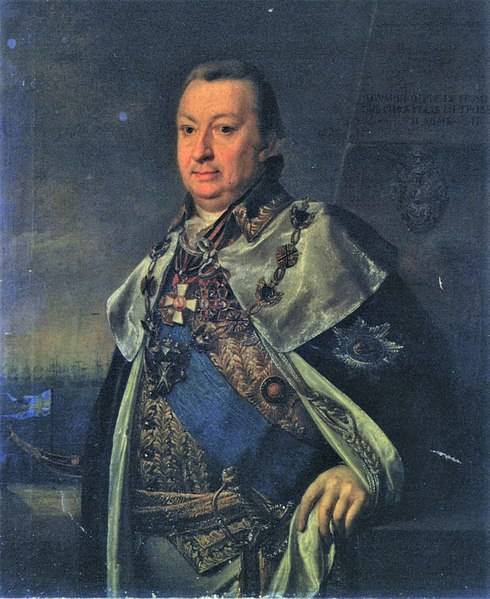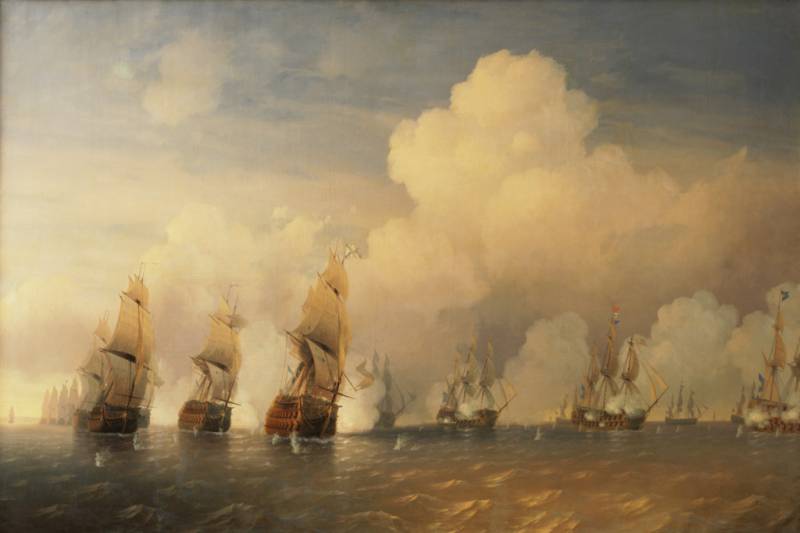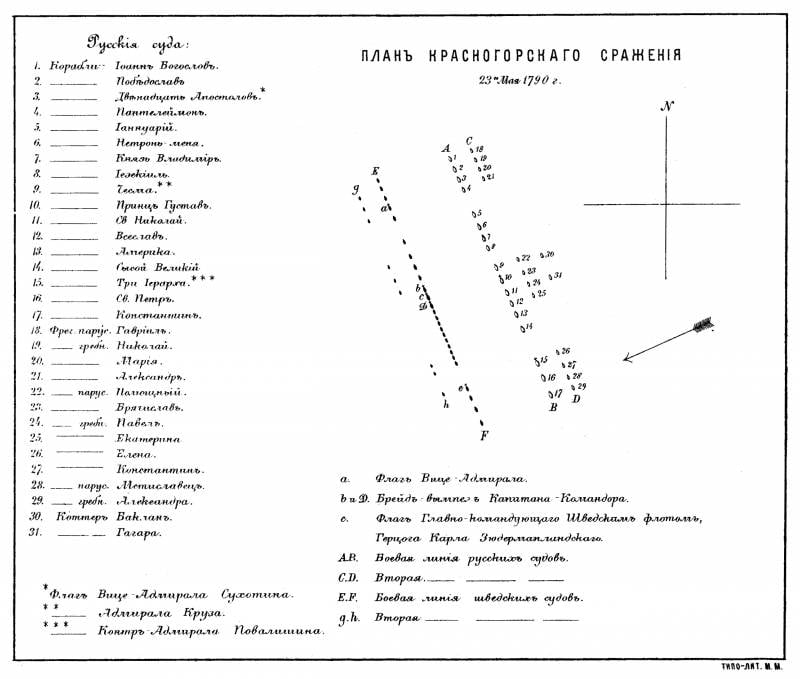Like Cruise, “thunder reflecting thunder”, saved Petersburg
Russian-Swedish War 1788 — 1790 230 years ago, in May 1790, a Russian squadron under the command of Cruise won a strategic victory in the battle of Krasnogorsk. The Russians did not allow the Swedish fleet to destroy our fleet in parts, break through to Kronstadt and threaten the capital.
Swedes go to the Russian capital
Despite the failure at Revel, the Swedish king did not abandon the plan of breaking the fleet to St. Petersburg in order to force the Russian queen to sign a peace favorable to Sweden. On May 21, 1790, the Swedish ships under the command of Karl Südermanland moved to Kronstadt. The Swedish fleet included 22 ships, 8 large and 4 small frigates, and several small vessels. They were armed with 2 thousand guns. At the same time, the Swedish rowing (army) fleet, which numbered 350 ships, headed to Björkezund under the command of the Swedish king Gustav III himself.
The Russian capital was restless. Since the beginning of the war, the enemy has never been so close to Petersburg. It was necessary to combine the Kronstadt naval squadron under the command of Alexander Cruz and the Revel squadron Vasily Chichagov, to prevent the Swedes from breaking them separately. At the same time, the Kronstadt squadron was hastily formed, armed, the crews were poorly trained. It was also necessary to direct the rowing fleet against the Swedish king, who was already near Vyborg. In St. Petersburg, with great relief, they received the news that Chichagov’s ships had repelled the enemy’s attack at Revel. Empress Catherine II asked Cruz not to let the enemy into the capital. The admiral promised that the enemy would not pass otherwise than on the chips of his ships.
In Kronstadt, thanks to the energetic activity of Cruise, it was possible to prepare 17 battleships, 4 frigates and 2 boats. It is worth noting that the Russian admiral of Danish descent was an experienced and brave commander. He was a member of several campaigns, in the Battle of Chios in 1770, his ship "Saint Eustache" fought with the Turkish flagship. Both ships collided, the Russians took the Turkish flagship on board. However, the Turkish ship burned and the fire spread to Russian. Both ships flew into the air. Cruise miraculously managed to escape. After this battle, Cruz, who was previously distinguished by cruel treatment of sailors (they didn’t even want to take him on a boat, the captain got an oar on the head), changed his treatment of his subordinates and earned their mutual love and respect throughout his future life.
May 12, 1790 the Russian squadron went to sea. Cruz planned to start moving on May 14, but a strong wind delayed the ships. For several days, the squadron maneuvered, crew exercises were conducted. Upon learning that up to 40 Swedish ships had assembled on the eastern side of Hogland, the Vice Admiral asked for 8 rowing frigates remaining in Kronstadt to be sent under the command of Captain Brigadier Dennison. By May 18, the Russian squadron had 17 ships, 4 sailing and 8 rowing frigates, 2 boats. They were armed with 1760 guns (1400 - on 17 battleships). The Russian squadron included: five 100-gun ships - “John the Baptist” (Cruise's flagship), “The Twelve Apostles” (flagship of Rear Admiral Sukhotin), “Three hierarchs” (flagship of Rear Admiral Povalishin), and Grand Prince Vladimir and "St. Nicholas"; one 84-gun Ezekiel; eight 74-gun ships - “John the Evangelist”, “Pobedoslav”, “Constantine”, “Saint Peter”, “Vseslav”, “Prince Gustav”, “Sisoy the Great” and “Maximus the Confessor”; two 66-gun ships - Panteleimon and Yanuari; one 64-gun ship Do Not Touch Me.
Thus, the Swedes had an advantage in the number of ships and guns. Also, the Swedish fleet was at sea for a long time, went into battle, and the teams of the Kronstadt squadron barely gathered, and they were at sea for 10 days. All this allowed the Swedish command to count on success in a naval battle and in a further landing operation to force St. Petersburg to peace. Nevertheless, Cruz expressed his willingness to attack the enemy.
The meeting of the two fleets
Due to low winds and headwinds, the Russian squadron moved slowly. By the evening of May 20, Russian ships were at Tolbukhin's lighthouse, where they were joined by a Dennison squad with 8 rowing frigates. On May 21, advanced ships discovered the enemy. By evening, the entire enemy fleet was visible. On May 22, the fleets adhered to each other. The Swedes did not use the opportunity to attack - the advantage of the windward position. In order to prevent the enemy from breaking through to Kronstadt, the Russian admiral placed his ships in a position between Cape Dolgim and Stirsuden (Krasnaya Gorka). Therefore, in Swedish sources, this naval battle is known as the "Stirsuden battle."
Both sides allocated light vessels in separate units to cover ships that would be damaged in the battle. The Swedes identified six frigates for this task, the Russians - four sailing and five rowing frigates. The fleets were divided into three parts. The main forces of the Russian squadron were commanded by Cruz, the vanguard - Sukhotin, the rearguard - Povalishin. A light detachment led Dennison. The Swedes formally the main forces were headed by the Duke of Kar. However, the Swedish king Gustav ordered to preserve the life of the duke (the king’s brother and a possible heir), and Karl with his headquarters switched to the frigate Ulla Fersen, having failed. And the main forces were de facto commanded by the captain of the flagship Gustav III Clint. Rear Admiral Modei was in charge of the vanguard, Colonel Leyonankern was the rear guard.
Battle
At dawn on May 23 (June 3), 1790, a light east wind was established. On Cruz’s attack “to attack the enemy with a shotgun”, the Russian squadron began to descend on the Swedes from the front, but soon lay down on a course almost parallel to the enemy. At about 4 o’clock in the morning, the advance detachments approached and opened fire. Advisor to the Empress Khrapovitsky noted: "The terrible cannonade is heard from dawn almost all day in St. Petersburg and Tsarskoye Selo." In the event of an unfavorable outcome of the battle, Kronstadt at that time was preparing to repel the Swedish attack. To cover the fairway, all remaining ships and vessels were used. Everyone who they could mobilized for fortifications and batteries: recruits, artisans, merchants, philistines, pupils of the Marine Corps, etc.
The movement was slow, so only after an hour all the ships entered the battle. Large Swedish frigates entered the line, taking places between their battleships. The Swedes concentrated fire on the Russian flagship and at the same time tried to suppress the northern flank of the enemy by superior forces. At five o’clock, the commander of the Russian avant-garde (northern flank) Sukhotin was torn off his leg with a nucleus, and he transferred command to the commander of his flagship “The Twelve Apostles”, Captain Fedorov, and asked not to weaken the onslaught. To help the right (northern) flank, Dennison advanced with his squad. His frigates entered the spaces between the ships. At the signal of Fedorov, Dennison's ships ceased fire, which interfered with the Russian ships, and the frigates moved further to the flank.
During the battle, the wind changed. From 7 o'clock the exchange of fire began to subside, the Swedish ships dodged west, and the Russians did not pursue them. By 8 o’clock the wind died down and the ships were at such a distance from each other that the battle stopped. At 11 o'clock a Swedish detachment of 20 rowing vessels left Björkösund. Their king sent to help the naval fleet. The Swedes wanted to attack the nearest Russian ships, but were repelled by the Dennison frigates, who on oars advanced to meet the enemy. After a small shootout, the Swedes retreated and disappeared into the skerries.
Meanwhile, the wind changed again and began to intensify in the afternoon. Once in the wind, the Swedish ships turned south, lay down parallel to the Russian squadron and attacked it, focusing fire on the flagship "John the Baptist" and the main forces of Cruise. However, the firefight was at a long distance, continued around and did not cause much damage. At 3 o'clock the fleets parted again and the battle ceased. At 6 o’clock in the evening the Swedish fleet again approached our ships, but did not approach a close range. Therefore, the battle remained indecisive, both sides did not lose a single ship. Only one Russian ship, "John the Theologian", went to Kronstadt for repairs. The wounded rear admiral Sukhotin was also sent to the base (he died from his wounds), but his flag remained on the ship, so as not to show the loss.
Swedes are retreating
At night, both squadrons remained at the scene of the battle, corrected the damage and prepared for a new battle. On the morning of May 24 (June 4) there was little wind. In the afternoon, a south-west wind blew, passing into the west and the Russian squadron formed a battle line. Upon receiving the news that the Russians had crossed the island of Nargen, the Swedes decided to resume the battle until the second Russian squadron approached. As soon as the Swedes attacked, the Russian ships retreated east, trying to lure the enemy into the depths of the shallow Kronstadt Bay. At 5 o’clock in the afternoon, the Swedish ships opened fire. Having received a lot of damage in the mast and sails, the Russian ships could not keep the line, the rear-guard vessels began to pile up. The Swedes tried to take advantage of this, cutting off the rearguard from the main forces. However, Cruz noticed the danger in time and sent the Dennison frigates to help the rear guard. As a result, the enemy’s maneuver failed.
By 8 o’clock the wind began to subside, the fleets again dispersed. Cruise squadron, turning several times through the fordewind (the course at which the wind is directed to the stern of the ship), was approaching Kronstadt. At about 8 a.m., the Swedes saw their frigate, who informed the fleet that the Russian Revel squadron was following him. The Swedes could fall between two fires and began to retreat to the west with a quiet wind. The Russian squadrons had not yet seen each other, but Cruz, who was watching the enemy, at 30 a.m. ordered to pursue the enemy. Fog and lack of wind made movement difficult.
May 25 Cruz ordered to attack the enemy upon detection. The Swedes have already left for the island of Seskar. On the morning of May 26, the Russian squadrons saw each other. The Swedish ship fleet at that time was leaving the island of Torsari, fulfilling the order of the king to enter the Vyborg Bay and protect the rowing fleet. Both sides in this battle lost about 400 people killed and wounded. On Russian ships there were 25 cases of gun rupture, 34 people died.
The actions of Admiral Cruise were quite reasonable. The Russian squadron, being weaker than the enemy fleet, taking advantage of the terrain, covered its flanks. closed Kronstadt and Petersburg, did not allow the enemy to pass and waited for the arrival of the ships of Chichagov. The enemy had to retreat to Vyborg Bay. It was a strategic victory with a tactical draw. Catherine II generously rewarded the participants in the battle. Admiral Cruz received the Order of St. Alexander Nevsky, the tsarina granted him a golden snuff-box decorated with diamonds, with the inscription: "Thunder reflecting thunder, he saved Petrovsky grad and the house."
The Swedes missed the opportunity to defeat the Russian fleet. They had an advantage in the number of ships, the strength of naval artillery, the number and quality of crews. The Swedish ships had a full set of experienced crew. There was a shortage of people on the Russian squadron; available were in haste, many were put on ships for the first time and had not yet seen the sea. Partly the mistakes of the Swedes are explained by the inconsistency of command. King Gustav sent captain Smith, who had the right to intervene in battle tactics, to the flagship of his adjutant. The direct management of the fleet was also divided between the Duke of Südermanland, who, at the insistence of the king, was sent to one of the frigates, and Colonel Clint, who remained on the flagship.
Among the mistakes of the Russian fleet, one can single out the actions of the Revel squadron of Chichagov. On May 23, Chichagov’s squadron left Revel and headed for Kronstadt to join the Cruise fleet. On May 24, Chichagov’s ships were off Seskar Island and was discovered by an enemy fleet leaving the battle at Krasnaya Gorka. Many Swedish ships were damaged, their ammunition was running out, and teams were tired of a two-day battle. The battered Swedish fleet did not dare to make its way past Chichagov to Sveaborg and hastened to take refuge in Vyborg Bay. That is, Chichagov had good chances to stop the Swedes and finish off the enemy upon arrival of Cruise ships.
However, Chichagov, due to the enemy, lay in a drift, and then, awaiting the Swedish attack, anchored in battle order. Justifying that he did not attack the Swedish fleet, the admiral referred to the “fog that happened”, which was hiding the enemy. Refuting this reason, Cruz in a report to Catherine II wrote:
Thus, the Russian fleet won a strategic victory in the battle of Krasnogorsk. Admiral Cruz prevented the Swedish fleet from destroying the Russian fleet in parts, breaking through to Kronstadt and threatening the capital. The weakened enemy fleet hid in Vyborg Bay, where a month later the United Russian fleet defeated it.



Information